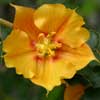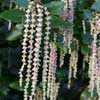 |
FREMONTODENDRON
'Tequila Sunrise' This wonderful new plant was bred here on the nursery when Nick crossed a rich orange form of Fremontodendron californicum with the large flowered bright yellow Fremontodendron 'Pacific Sunset'. The result is a superb plant with distinctly more orange flowers than any you've seen before! The usual conditions for growing Fremontodendron are required - a sunny site with good drainage, usually against a south facing wall where you will be rewarded with a succession of magnificent flowers form May until November. |
|
|
|
 |
GARRYA
x issaquehensis 'Glasnevin Wine' (G. elliptica x G. fremontii) A handsome evergreen producing long, rich coloured catkins with red bases to the green bracts and yellow anthers, in January-February. The extra colour gives the plant another dimension! Shelter of a wall is beneficial in cold or windier areas. This lovely plant is smaller in all its parts than the more commonly available forms of G. elliptica. |
|
|
|
| GINKGO biloba Supposedly the oldest surviving species of tree, with fossils dating back to prehistoric times. Technically a conifer, but deciduous with "leaves" rather than needles. The leaves are fan-shaped and undivided with stunning yellow autumn colour. My kids call it the "dinosaur plant" and when they were small they loved to collect the brightly coloured leaves in autumn. |
|
|
|
|
| GINKGO biloba
'Saratoga' Smaller growing than the type and therefore more suitable for modern gardens! The leaves are long, narrow and deeply divided giving them a graceful appearance. A really lovely form, particularly in the autumn when it turns yellow. |
|
|
|
|
 |
GINKGO biloba
'Variegata' We imported our stock plants from Japan and it has taken several years for us to get it into production as it is very slow. We have been very careful to propagate from variegated shoots, so the resultant plants should have respectable colour. Best in light shade to prevent leaf scorch. Very slow growing. |
|
|
|
| GREVILLEA victoriae | |